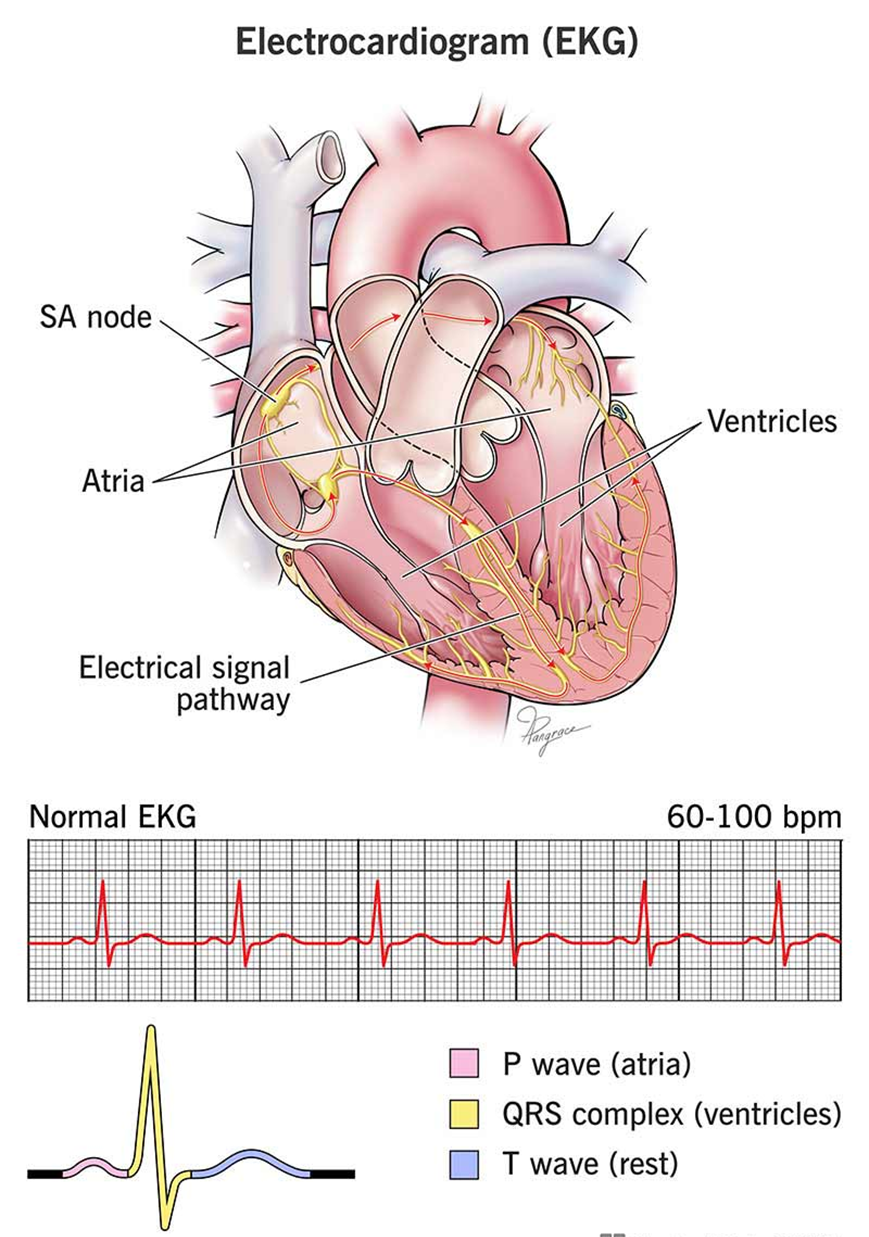Which of the following diagnostic tests is commonly used to assess heart failure?
Pulmonary function test
Electrocardiogram (ECG)
Urinalysis
Complete blood count (CBC)
The Correct Answer is B
Choice A Reason:
Pulmonary function tests are used to assess lung function and diagnose respiratory conditions such as asthma, chronic obstructive pulmonary disease (COPD), and other lung disorders. While heart failure can affect lung function, pulmonary function tests are not specifically used to diagnose heart failure.
Choice B Reason:
An electrocardiogram (ECG) is a common diagnostic test used to assess heart failure. It records the electrical activity of the heart and can detect abnormalities in heart rhythm, heart size, and the presence of ischemia or infarction. ECGs are crucial in diagnosing and monitoring heart conditions, including heart failure.
Choice C Reason:
Urinalysis is a test that examines the content of urine and is used to diagnose and monitor kidney function, urinary tract infections, and other metabolic conditions. It is not specifically used to diagnose heart failure, although kidney function can be affected by heart failure.
Choice D Reason:
A complete blood count (CBC) measures the levels of different blood cells, including red blood cells, white blood cells, and platelets. While a CBC can provide valuable information about a patient's overall health and detect conditions like anemia or infection, it is not specifically used to diagnose heart failure.

Nursing Test Bank
Naxlex Comprehensive Predictor Exams
Related Questions
Correct Answer is A
Explanation
Choice A Reason:
Urine output is one of the most reliable indicators of adequate fluid resuscitation in burn patients. The goal is to maintain a urine output of 0.5 to 1 mL/kg/hour in adults³. This parameter is crucial because it directly reflects renal perfusion and, by extension, overall circulatory volume status. When fluid resuscitation is adequate, the kidneys receive enough blood flow to produce urine at this rate, indicating that the body's tissues are being adequately perfused. Monitoring urine output is a non-invasive and straightforward method, making it a preferred choice in clinical settings.
Choice B Reason:
Heart rate can be an indicator of fluid status, but it is less reliable than urine output. Tachycardia (an increased heart rate) can occur due to pain, anxiety, or other stressors, not just fluid deficit. While a decreasing heart rate might suggest improving fluid status, it is not a definitive indicator on its own. Other factors must be considered in conjunction with heart rate to assess fluid resuscitation adequacy.
Choice C Reason:
Blood pressure is another parameter used to assess fluid status, but it can be influenced by many factors, including the patient's baseline blood pressure, medications, and the presence of other medical conditions. While maintaining adequate blood pressure is important, it is not as sensitive or specific as urine output for assessing fluid resuscitation in burn patients. Blood pressure can remain within normal ranges even when fluid resuscitation is inadequate, especially in the early stages.
Choice D Reason:
Mental status can be affected by fluid status, but it is a late indicator of inadequate perfusion. Changes in mental status, such as confusion or decreased level of consciousness, can occur when there is significant hypoperfusion and shock. By the time mental status changes are observed, the patient may already be in a critical state. Therefore, it is not a primary indicator for assessing fluid resuscitation adequacy.
Choice E Reason:
Capillary refill time is a quick and simple test to assess peripheral perfusion. However, it is not as reliable as urine output for evaluating overall fluid status. Capillary refill can be affected by ambient temperature, lighting conditions, and the examiner's technique. While a prolonged capillary refill time can indicate poor perfusion, it is not as specific or sensitive as urine output for assessing fluid resuscitation adequacy.
Correct Answer is ["7.2"]
Explanation
Step-by-Step Calculation:
Step 1: Convert the client's weight from pounds to kilograms.
176 lbs ÷ 2.2 = 80 kg
Result = 80 kg
Step 2: Calculate the total dose of dopamine in mcg/min.
3 mcg/kg/min × 80 kg = 240 mcg/min
Result = 240 mcg/min
Step 3: Convert the total dose from mcg/min to mg/min.
240 mcg/min ÷ 1000 = 0.24 mg/min
Result = 0.24 mg/min
Step 4: Determine the concentration of dopamine in mg/mL.
500 mg ÷ 250 mL = 2 mg/mL
Result = 2 mg/mL
Step 5: Calculate the infusion rate in mL/min.
0.24 mg/min ÷ 2 mg/mL = 0.12 mL/min
Result = 0.12 mL/min
Step 6: Convert the infusion rate to mL/hr.
0.12 mL/min × 60 min/hr = 7.2 mL/hr
Result = 7.2 mL/hr
Final Result:
The IV pump should be set to 7.2 mL/hr.
Whether you are a student looking to ace your exams or a practicing nurse seeking to enhance your expertise , our nursing education contents will empower you with the confidence and competence to make a difference in the lives of patients and become a respected leader in the healthcare field.
Visit Naxlex, invest in your future and unlock endless possibilities with our unparalleled nursing education contents today
Report Wrong Answer on the Current Question
Do you disagree with the answer? If yes, what is your expected answer? Explain.
Kindly be descriptive with the issue you are facing.
